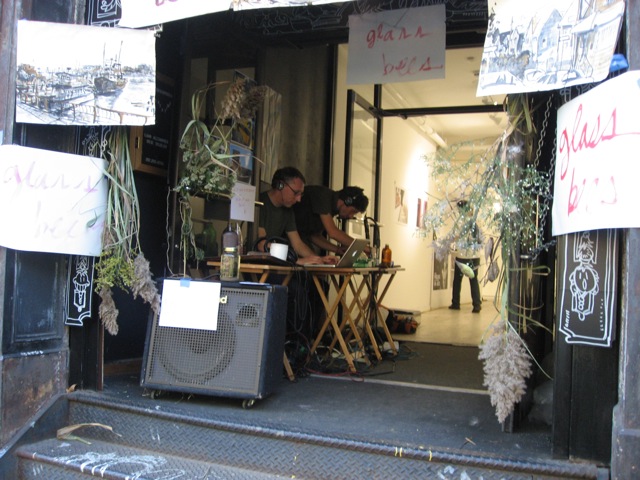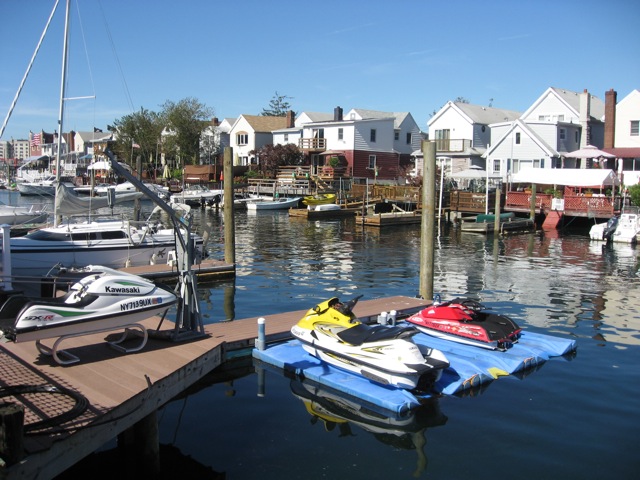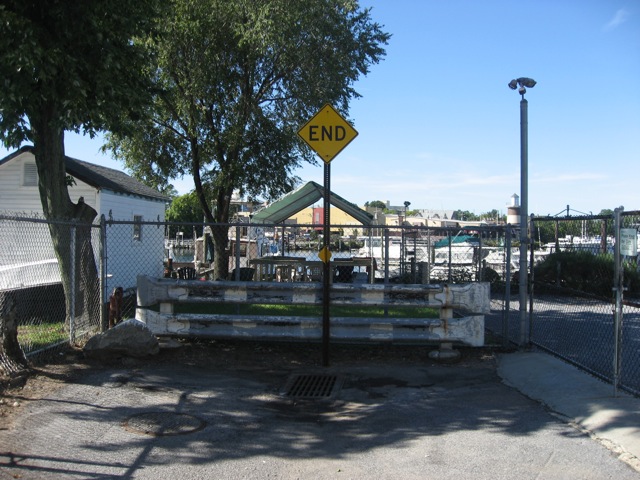Venice, Brooklyn was a shotgun multimedia improvisation assembled and performed by the Glass Bees on September 20, 2009. Early that morning, Jason Das and I traveled to areas along the Atlantic coastline in southern Brooklyn, specifically visiting neighborhoods and marshland that scientists have predicted to be vulnerable to the effects of climate change in the coming decades. We visited Dead Horse Bay, Floyd Bennett Field, Gerritsen Beach, and Sheepshead Bay, documenting them with sound recorders, photographs, watercolor sketches, and video, and collecting objects we found there. Later that day, we presented an improvised performance in the front vestibule of Envoy Enterprises, a gallery in Chinatown, New York City. Our field recordings, visual footage, and physical detritus became the raw material for a sound collage and temporary installation. Amplified sound was broadcast into the street, and visitors were invited into the gallery to listen more closely on headphones. All materials and sounds we presented were gathered, created, displayed, performed, and disassembled within an 11-hour period.

In a formal sense, Venice, Brooklyn was a significant stage in the ongoing evolution of the Glass Bees. From our inception, a core goal has been to adapt and respond to the situations in which we find ourselves, improvising with the materials we have at hand. But although we first formed as a purely musical project, our approach to improvisation is increasingly open to experimentation in other registers. In this case, our perambulations early in the day were conducted in the spirit of the Situationist dérive. Our motions were an attempt to actively engage with the city, getting lost while discovering corners previously unknown to us, paying close attention to things typically unobserved, exposing hidden histories, and finding utility in objects that have no use. Although we set out that morning with a general sense of what we were looking for, what we returned with was largely accidental. Our installation in a gallery in Chinatown constituted an improvised, impressionistic remix of what we had experienced earlier in the day.
We developed this project in response to a call for proposals issued by the Conflux Festival. Conflux is a New York City-wide gathering of visual and sound artists, writers, urban adventurers, and the public, created to “investigate everyday urban life through emerging artistic, technological, and social practice.” Our interest in climate change and its potential effects on the city came out of my work as a science editor. It’s been difficult to avoid thinking about this profoundly depressing issue, and our inability, at all levels of society, to properly reckon with it. For centuries, people up and down the Atlantic seashore have built their lives, their communities, their very dreams on the assumption that land is land, and sea is sea. But the line demarcating these two worlds is slowly crawling uphill, making the precautions we have engineered increasingly insufficient. It is now conceivable that someday the locations we visited could suffer a similar fate as New Orleans, or Venice, or Bangladesh, all of which are in the process of being submerged. What would be lost if these areas were inundated, we wondered, and how are people preparing?

Like the haul of some anachronistic anthropological excavation, the evidence we gathered in our fieldwork was largely quotidian, but often telling. The sounds we used during our performance at Envoy were sampled from field recordings of what we encountered—antique bottles washed up on the shore, dumped in the bay decades ago but mysteriously resurfaced as litter once again; a bristle-less hairbrush, corroded clean by the brackish water; a watchdog protecting its owner’s property; a young girl pulling a wagon; shortwave weather reports; and interviews with people we met along the way. The photographs we took and the watercolors Jason painted were snapshots of life in these places—a row of houses and the canal in Gerritsen, advertisements for new harborfront condominiums at Sheepshead, a path through the marshland, a table of trophies, a pinwheel, a dilapidated barn.

An elderly woman who took interest in Jason’s sketching explained to us that Gerritsen Beach was initially developed as a small community of summer cottages, inaccessible in the winter and occupied during the hot weather. That people have since built out these cabins into larger, more permanent houses just a few feet above sea level suggests an indomitable impulse to claim the coast and its watery pleasures. It also speaks to what Columbia University climatologists Klaus Jacob, Vivien Gornitz, and Cynthia Rosenzweig once described, in a study of the potential effects of climate change for New York, as “littoral environments … caught between the twin pressures of development and increasing coastal hazards.” Like the nearby Whitney Mill that years ago served as an industrial focal point of the area, this unique and charming neighborhood of narrow streets, short blocks, and dense housing could someday be abandoned, this time badly flooded or even swallowed by the ocean.
That day we also passed through coastal areas that remain sparsely developed, a buffer zone to mitigate the consequences of storms for the city’s inland settlements. Home to abandoned barracks and functional U.S. Marine and Coast Guard installations, these isolated areas also offer open spaces psychically far removed from the congestion just a few miles up Flatbush Avenue. At Floyd Bennett Field we found a miniature formula 1 race course for remote control car enthusiasts. When we approached holding our audio recorder, the organizer introduced himself, explaining that he’d been afraid we were from the Parks Department, recording decibel levels as evidence for a complaint against him. After reassuring him that we had no intention of causing problems, he told us about the troubles his club faces in finding a permanent place to enjoy their hobby. They’d been evicted form the Aviator Club when the former aircraft hangar was turned into a sports complex, and now made the best they could of an uneven patch of tarmack they’d claimed. As the cars hurtled around the course at startlingly high speeds, his story was one of displacement, of a small but enthusiastic community forced to relocate due to forces beyond their control.

With flood prediction maps in hand, it was not difficult to see that in the long term, the built environment around us was similarly provisional, temporary, and in the process of migration. Scientists now know that certain effects of climate change are irreversible and unavoidable, and governments and individuals will be forced to adapt to a new reality. If they don’t, places around the world including these outlying regions of New York will be endangered, and their residents will be uprooted for higher ground. Many of those places will have an even harder time coping.
In Manhattan, concrete and glass high-rises belie the fact that millions of people live here on islands, and that their settlements rest just feet above sea level. To us it seemed provocative, then, to bring peripheral areas into dialogue with Downtown. Models of the potential effects of severe storms in Manhattan predict that neighborhoods not far from the Envoy Enterprises storefront could also be inundated. Even moderate storms will have the power to render the city’s infrastructure useless, as occurred one morning in the summer of 2007, when an early morning downpour incapacitated the city’s subway system, leaving thousands of commuters with no choice but to hike miles to work. How are we preparing for a potentially far worse sequel? Could we do anything about it if we wanted to?
Fundamentally, the question of what investments and sacrifices we are willing to make to cope with the effects of climate change is a complicated calculus of risk assessment. With so much competing information and so many unknowns about the extent of climate change’s effects, how do we define a reasonable level of preparedness? Such questions are not new, and evidence of the ways in which we have answered them fill the space around us. This is a theme that the Glass Bees have explored before, and in this sense we see Venice, Brooklyn as part of an ongoing project begun in a July 2009 performance we held at Monkeytown, a venue in Brooklyn. There, we (along with sound artist Andrea Williams) improvised a soundtrack to a two-channel video projection created from footage gathered at Fort Hancock on Sandy Hook, New Jersey. Although today it is primarily a destination for weekend getaways to the beach, Sandy Hook has a long and rich military history, dating back to the nineteenth century, when bunkers were dug into the dunes to protect New York Harbor. The fortifications developed as technology evolved, eventually including a Nike missile installation erected in the 1950s to shield the city from Soviet bombers. All of these defenses eventually became obsolete and were abandoned.

No attack ever came against New York, but does that mean that these precautions were foolhardy? We will never know. Because the fossils of this era sit on a sandbar just a few hundred feet wide at some points, however, we might expect that nature’s invasion of the same terrain will have dramatic effects, and strategies against it will become increasingly difficult to devise. Can we live with this? How are we preparing for these changes? The very week that Venice, Brooklyn took place, world leaders met in the United Nations General Assembly, once again averring that something must be done to address climate change, but refusing to make concrete proposals about the measures everyone knows are needed. With a major climate change conference coming up in Copenhagen later this year, prospects are looking increasingly slim that the essential consensus needed to address this complicated, global issue will materialize.
In a small way, Venice, Brooklyn was an attempt to focus on the material reality of what is at risk. Data and statistics can seem abstract to the nonscientist, and it won’t be until people’s lives are impacted in concrete, physical ways that the full extent of the phenomenon will be understood.
Although the trends are clear, climatologists admit that the specific effects of climate change are difficult to predict. New York City will have no alternative but to improvise, to adapt to the changing environment in which we find ourselves… perhaps not unlike a certain, transitory multimedia installation presented on a stoop in Chinatown.
Visit the Glass Bees for audio and video from this performance.
